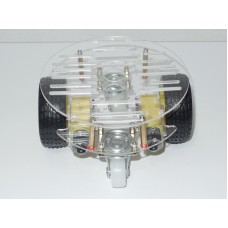Wheels are by far the most popular method of providing mobility to a robot and are used to propel many different sized robots and robotic platforms. Wheels can be just about any size, from a few centimetres up to 30 cm and more . Tabletop robots tend to have the smallest wheels, usually less than 5 cm in diameter. Robots can have just about any number of wheels, although 3 and 4 are the most common. Normally a three wheel robot uses two wheels and a caster at one end. More complex two wheeled robots may use gyroscopic stabilization. It is rare that a wheeled robot use anything but skid steering (like that of a tank). Rack and Pinion Steering such as that found on a car requires too many parts and its complexity and cost outweigh most of its advantages.
Four and six wheeled robots have the advantage of using multiple drive motors (one connected to each wheel) which reduces slip. Also, omni direction wheels or mecanum wheels, used properly, can give the robot significant mobility advantages. A common misconception about building a wheeled robot is that large, low-cost DC motors can propel a medium sized robot.
Four Wheeled Robotic Platform for Arduino or Raspberry Pi
- Product Code: Robotplatform1
- Availability: 2-3 Days
-
$39.99
Tags: Robotics




